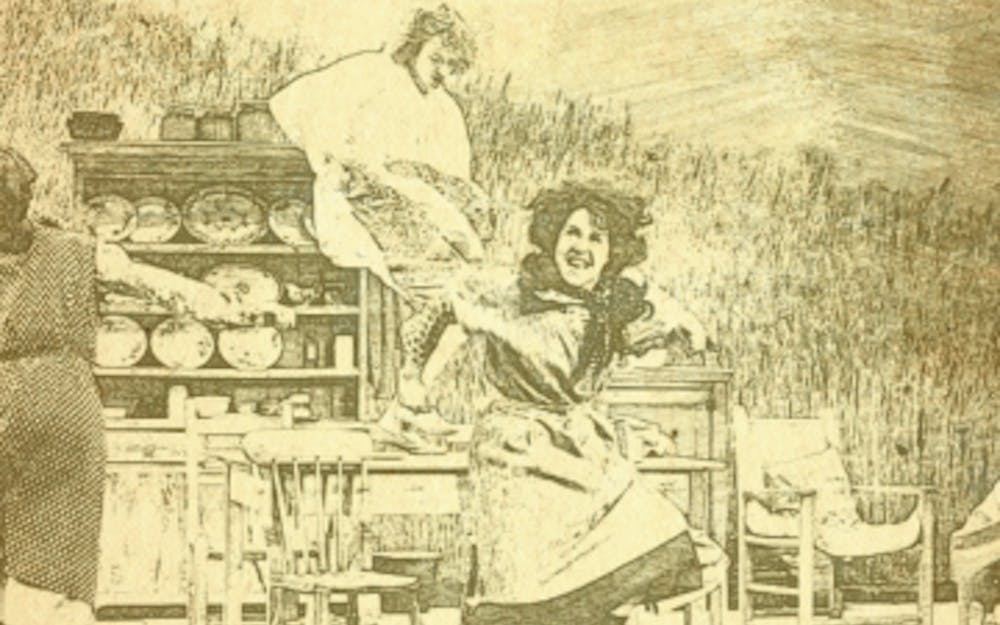As the darkness lifts, seven frozen figures are revealed on a dimly lit stage. Their stagnant poses and stoic demeanors create a hazy atmosphere, pulling the audience into what seems to be a memory, or perhaps a dream. The spell-like ambiance is disrupted by a figure moving toward the audience, speaking in a deep Irish accent. This figure is our narrator, Michael, who explains that the scene the audience is about to enter is one of mixed emotions. A note of excitement accompanies the arrival of a radio in the mundane lives of a family of five unmarried sisters. Any uplifting sentiments, however, are shrouded in deep melancholy, as the sisters mourn the sickly return of their brother, Jack, from Africa and the unreliability of Gerry, Michael’s illegitimate father.
Although Michael’s introduction is only a few minutes long, this tone of melancholic reflection is one that carries throughout the Theater Studies fall show, "Dancing at Lughnasa." This dreamlike sadness is created through a combination of acting, costumes and an interactive set.
What particularly put the audience in 1930s Ireland is the strong accent used by the entire cast. Although the accents seemed effortless, honing this dialect was no small feat. Actors worked with Kirby Wahl, professor of performing arts at Elon, who specializes in dialect coaching. Wahl helped the actors to recognize which letters and parts of words should be enunciated, curtailed or elongated.
“The dialect training was surely a very tedious process,” said sophomore Bryant Lewis, who played Jack Mundy. “It was frustrating at times, trying to break habits of speech we're so accustomed to.”
To try to get over American speech patterns and embrace the Irish accent, director Ellen Hemphill encouraged actors to speak in the Irish accent as frequently as possible, even around their friends or family. The hard work paid off, as the accents bring the characters to life and transported the audience to a different world.
“Using the dialect helps us to truly become our characters,” Lewis said. “It's also just a fun skill to have.”
Despite the title of the show, only a few scenes include dancing. These scenes reveal the importance of dance in Ballybeg, where the play is set, with particular focus on the characters’ dependence on dance as a form of escape. Although the play is full of tragedy, the dancing of the Mundy women brings happiness to the show. These dances transport them back to the happier, more hopeful times of their youth and serve as a means of bringing together a family that is falling apart.
“Our main goal with the dance scene was to portray to the audience that Irish dance is such a large part of the Mundy sister's world as well as a method of escapism for all of them,” said senior Anna Waters, who plays Agnes Mundy.
Dance also brings the sisters together, a purpose underscored in the final image of the show, when the five sisters dance and clasp hands, forming a ring, both literally and figuratively uniting the diverse perspectives of these jaded characters. The actors worked with a dance coach to make the dances authentic to 1930s Irish tradition.
“We learned multiple Irish dance routines before we choreographed the dance that we did in the show,” said Waters.“It was challenging to express each character's unique personality throughout the dance while also bringing them all together as one.”
Costumes also play a key role in bringing the show to life. The seemingly mundane color scheme and styles of the outfits help set the stage for the phase of life that these characters are in as unmarried, middle-aged women in 1936 Ireland. Derrick Ivey, who led costume and set design, explained that his image for the costumes was based on several Van Gogh paintings that focused on women.
These paintings spoke to Ivey as he planned the costumes, as the unreliable presence of men in the painting but consistent presence of women mirrored the sisterly connections in the face of disappointing male figures in the show. Ivey said that these paintings, while largely done in cool colors, have highlights of pink. The female costumes similarly used primarily neutral colors, but the women had pink slips under their clothes that were revealed only when they danced.
“Dancing at Lughnasa” pays similar attention to the set, which features a screen that changes throughout the play. For much of the show, the screen has a wall projected on it to make up the house that the women inhabit, but when characters have monologues where they reminisce about times from their past, the background changes accordingly to bring the audience into their reveries. When Jack tells extended stories about his time in Africa, the background changes to tall grass and huts. Similarly, when Chris tells a story about a dreamy, love-filled evening from her childhood, the background shifts to a starry night. In the final scene, the background shows slow-motion videos of the characters, at first looking sullen and then dancing, serving as a final reminder of the complicated blend of excitement and melancholy that is delicately interwoven throughout the show.
The cast and crew of “Dancing at Lughnasa” bring the story to life through their setting and characters, creating a thought-provoking and saddening experience for the audience. Although the play ends on a melancholy note, with death and foregone love as prominent themes, there is promise in the life of the narrator, young Michael. He is a byproduct of a broken household, but he carries a backpack with him, presumably on to explore what is beyond the sorrowful memories of Ballybeg.
Get The Chronicle straight to your inbox
Signup for our weekly newsletter. Cancel at any time.

